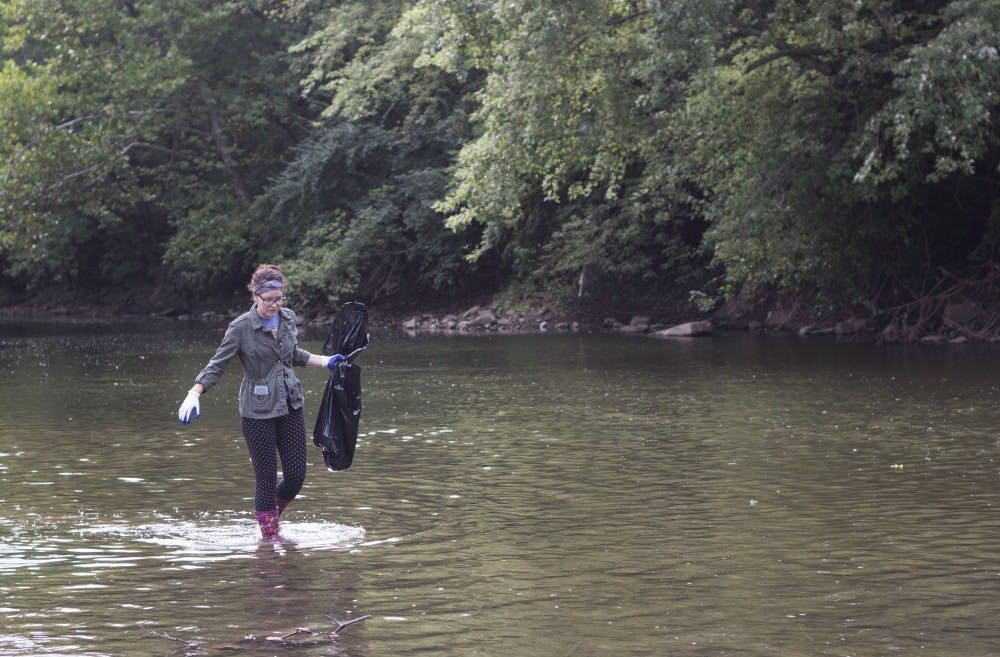In the 1970s Muncie’s economy relied on the money and jobs factories brought in. They also brought in a not-so-positive side effect as well — pollution.
Factories would dump harmful chemicals into the river by the gallons each day.
Muncie’s water has improved dramatically. But people’s perception of it has not.
According to a report from Indiana American Water, the company that provides Muncie with its water and the largest investor-owned utility in Indiana, Muncie’s water is of higher quality than in most other Indiana cities and numerous other cities throughout the nation.
Indiana ranked 30th among the 50 states in the U.S. for water quality in 2015, according to the personal finance website WalletHub that released its report on 2015’s Most & Least Eco-Friendly States in April 2015.
“Our water utilities perform many tests each day to ensure that our customers receive high-quality drinking water,” according to the Indiana American Water company’s website.
The city of Muncie uses both surface and groundwater for its supply, according to the Indiana state government website. Surface water comes from the White River and from the Prairie Creek Reservoir, while ground water comes from several wells in the Muncie area.
John Craddock, director emeritus of the Muncie Sanitary District, started doing research on the White River in the 1970s, which resulted in the dramatic increase in the water quality of the river.
Craddock funded his research with his own money. He then influenced the Muncie Sanitary District to make a part-time position so he would have someone to aid him.
According to the Muncie Sanitary District website, following his speech at the first Earth Day on Ball State’s campus in April 1970, newspapers ran a series of articles informing the public of Craddock’s research. Muncie citizens, surprised at the quality of the White River, started asking questions.
Craddock said during the 1970s, his goal was to decrease general river pollution, starting with industrial pretreatment. The Muncie Sanitary District and Craddock worked to implement pretreatment systems for large industries to treat their water that was filled with harsh chemicals before sending it to the wastewater treatment plant.
“The condition of our river reflects how we feel about our natural resources and view ourselves, as well as how others view our community,” Craddock said on the Muncie Sanitary District website.
Since the 1970s the river’s zinc concentrations have been reduced 77 percent, Chromium has been reduced 83 percent, and lead has been reduced 97 percent.
Although water quality experts who work for Indiana American Water and the Muncie Wastewater Treatment Plant have the proof to back up the quality of Muncie’s water, various Ball State students still worry.
Ball State senior fashion merchandising major Jillian Hooper said Muncie water doesn’t measure up to the water at her house in her hometown of New Palestine, Ind.
“Any time I fill up a glass of water, white particles are floating around the cup,” Hooper said. “Sometimes they stick to the cup, and other times they float in the water. I’m not really sure what they are, but I’ve never experienced that anywhere else. And it makes me nervous to think about what it may be.”
Sophomore elementary education major Jenny Schultz has similar feelings.
“I don’t know what it is, but Muncie water just doesn’t taste as good to me,” Schultz said. “It looks pretty cloudy sometimes, too. I just can’t imagine that it’s clean enough.”
Some students insist on drinking bottled water because they think bottled water is cleaner. However, according to the Indiana American Water website, there actually isn’t any evidence that bottled water is better than tap.
“All tap water is required to meet strict standards set by the USEPA under the Safe Drinking Water Act,” the site reads. “The water provided by community water systems is regularly tested for compliance with state and federal regulations, whereas bottled water suppliers do not have such stringent regulatory requirements.”
When it comes to the White River’s water, the students’ opinions don’t vary much there, either.
“I probably wouldn’t ever swim in it or eat fish out of it,” Hooper said. “It seems like the kind of place where I’d grow a third eye if I swallowed the water.”
While the Muncie drinking water is better than it was 40 years ago, the municipal water of the White River area has more chemicals and pollutants in it than the national average, according to the National Drinking Water database. This area includes Anderson, Noblesville, Fishers and Indianapolis.
The drinking water has six chemicals, compared to an average of four nationwide, and 13 pollutants found in the Muncie drinking water, compared to eight on the national average. However, the Indiana Department of Environmental Management has reported no violations for drinking water since 2004.
Cleaning the White River
Although the water pulled from the White River in Muncie for drinking water exceeds state and federal regulations after the water company treats it, the river itself is known for being trash-ridden.
The Muncie area community has sponsored a cleanup of the White River for nine years now. In the past eight years, the White River Cleanup website said, volunteers have cleared more than 85,000 pounds of trash and more than 600 tires from the river.
Each year roughly 400 volunteers volunteer for the project.
Many of the volunteers are Ball State students. Officials at the university urge students to get involved to raise awareness about water issues and to inform them about sanitation issues.
According to the National Resources Defense Council, dirty water is the world’s biggest health risk and it consistently threatens quality of life and municipal health in the United States.
When water from rain and snow slides off buildings and roads into the rivers, it can pick up poisonous chemicals, dirt, waste and disease-carrying bacteria. Many of Indiana’s water reserves lack essential protections, making them susceptible to contamination from factory farms, industrial plants and activities like fracking.
The Muncie Wastewater Treatment Plant handles the run-off and wastewater from the city of Muncie, Ball State and some surrounding areas, including Selma and Royerton. Polluted water flows into this plant for treatment 24 hours a day, seven days a week, 365 days a year.
The Muncie Wastewater Treatment Plant pumps 16.5 million gallons of treated water into the White River every day. The plant does not treat the water from the White River, but rather ensures the water they put into it is cleaner than necessary for those downstream.
Water flows through sewage systems under Muncie’s roads that run into the treatment pipes at the wastewater treatment plant. The plant’s mechanics filter the sewage water into three separate treatment processes before it is allowed to flow into the White River.
Muncie and other cities about the same size use a treatment process called activated sludge. The polluted water goes through primary, secondary and tertiary treatments.
In the primary stage, water is filtered through screens and is strained to remove any debris such as plastic, latex, sticks and any inorganic grit. After this, what is left in the water is very fine, biological organic waste.
To treat the water during the second stage, the facility introduces microorganisms. The wastewater treatment plant’s staff members put microscopic organisms of various kinds in an aerated tank, and these organisms continue to clean the water. They feed on the waste in the water, reproduce and then clump together.
Then, in a different section of the tank, it settles out. The microorganisms essentially clean the water.
By the end of secondary stage the water is treated wastewater and is mostly clean and clear, especially to the naked eye.
Some treatment plants, especially smaller ones, stop here, because the water is clean enough to meet state and federal regulations at this point.
Instead, the facility in Muncie goes one step further, and uses a third final treatment. This stage is optional, but government leaders over the years have opted for Muncie to take this extra step.
During the third step, the water goes through basins containing multiple types of sand and gravel. When the water flows through these basins, it is given one final polish before it is released out into the public river.
John Barlow, superintendent of Muncie’s Wastewater Treatment Plant, said a glass of the treated wastewater would be virtually impossible to distinguish from a glass of tap water by the time it leaves the facility.
Each year, Muncie water and wastewater must meet certain state and federal regulations, and Barlow said Muncie has exceeded those standards each year for more than 30 years.
From April through November, the water is also disinfected for E. coli. The treatment center uses chlorine to disinfect water and sulfur dioxide to remove the chlorine from spreading into the river water.
During a normal flow day, the water treatment process takes about eight hours. However, if there is a storm or a lot of snow melting and flowing into sewage drains, the water will move through the system more quickly, making the process go even faster.
Because the White River is constantly moving, the water put out by the facility is only a fraction of what is takes to fill the river as it flows downstream.
Barlow said his goal is to keep the water in the White River as clean or cleaner than it was before, and for the past 30 years, the water has always been above federal and state regulations.





